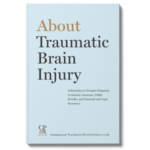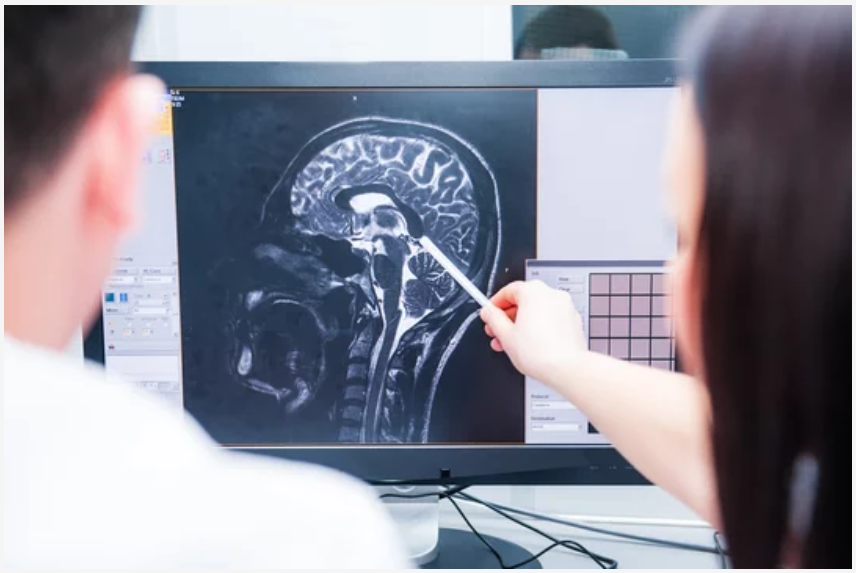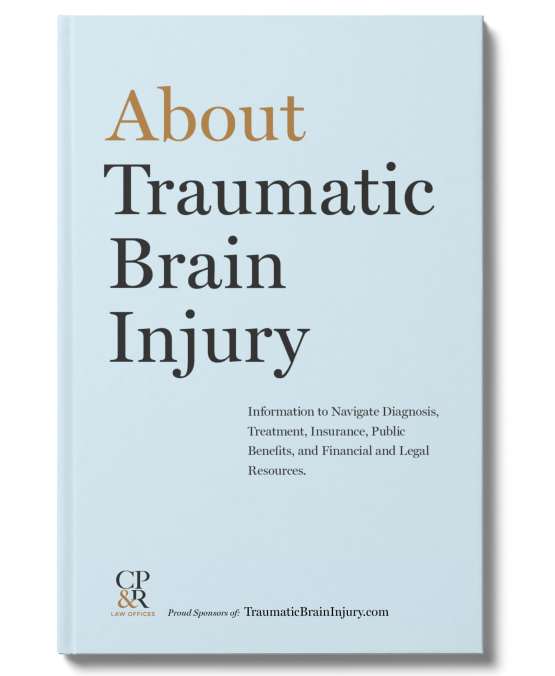What Is Traumatic Brain Injury?
A primer on the types of brain injuries, the causes, treatments, and stages of recovery
Request our Free Book on Traumatic Brain Injury

The U.S. Centers for Disease Control and Prevention defines Traumatic Brain Injury (TBI) as a disruption in normal brain function caused by a penetrating head injury or a bump, blow, or jolt to the head.
Since the brain defines who a person is, the consequences of an injury like this can affect all aspects of a patient’s life, right down to their basic personality. Also called an intracranial injury, TBI is different from a broken limb or punctured lung. An injury in these areas limits a patient’s use of a specific body part, but their personality and ability remain unchanged. Most often, these body structures heal and regain their previous function.

But traumatic brain injuries do not heal like other injuries, and recovery is based on mechanisms that are not fully predictable. No two brain injuries are alike, and the consequences of two similar injuries are often very different — with symptoms that can appear right away or arise days or weeks after the injury.
Understanding what a traumatic brain injury is — along with its symptoms, causes, and treatments — can help in early identification and management, leading to better outcomes for all of those affected by this often life-changing diagnosis.
Key Facts
2.5 Million
approximate number of people who suffer a TBI each year
50,000
result in death
80,000
result in permanent disability
28%
Traumatic brain injuries are caused by accidents and falls
Leading Causes of Traumatic Brain Injury
The leading causes include:
- Falls (28%)
- Motorcycle and motor vehicle crashes (20%)
- Being hit by or colliding with an object (19%)
- Assaults (11%)
- Other — Spinal cord injuries, sports injuries, birth injuries, cerebral palsy, and medical malpractice/negligence (12%)
Sources: The Brain Trauma Foundation and U.S. Centers for Disease Control and Prevention
Who is Prone to Traumatic Brain Injuries?
Traumatic brain injuries can occur at any age, in any setting, and regardless of safety precautions taken. However, those who are exceptionally young or old, those who use drugs and alcohol, and those who engage in high-risk activities and jobs are far more likely to suffer from TBI.
Motorcycle Accidents and TBI
Protect your rights and recovery. For information on understanding TBI caused by motorcycle accidents, including causes, symptoms, treatments, and legal options for compensation, read our article “Traumatic Brain Injuries From Motorcycle Accidents”.

A Look at Traumatic Brain Injury Symptoms: Mild, Moderate, and Severe
Symptoms of TBI are classified as mild, moderate, or severe by medical practitioners. However, these labels can be misleading and overly simplistic because they fail to capture the complex nuances of how an individual patient’s brain function is affected by such injuries. A “mild” TBI, such as a concussion, can lead to significant cognitive, emotional, and physical impairments that profoundly disrupt a person’s daily life, challenging the assumption that the term indicates a lack of serious consequences. On the other hand, a “severe” TBI might suggest universally grave outcomes, whereas some individuals may experience varying degrees of recovery and adaptation, while others survive in a vegetative state. These labels are not helpful in understanding the true functional impact of TBI on patients’ lives.
That said, in the most extreme cases, patients may experience paralysis, coma, or a persistent vegetative state showing no signs of awareness for an indefinite period.
Most TBI cases will range from mild to moderate with patients experiencing some or all of the following signs and symptoms:
Physical Symptoms of Traumatic Brain Injury
- Headache(s)
- Sensitivity to light or sound
- Dilation of one or both pupils
- Nausea or vomiting
- Change in eating or nursing habits
- Loss of consciousness
- Fatigue
- Inability to awaken or other changes in sleeping patterns, such as trouble falling or staying asleep, or sleeping more or less than usual
- Dizziness
- Loss of balance and coordination, including trouble walking
- Ringing in ears
- Double or blurred vision
- Slurred speech
- Numbness or tingling in extremities
- Spasticity
- Muscle weakness
- Seizures
Cognitive Symptoms of Traumatic Brain Injury
- Feeling foggy or confused
- Slow thinking or processing
- Memory issues
- Inability to concentrate
- Poor judgment
- Falling behind in school
Emotional and Behavioral Symptoms of Traumatic Brain Injury:
- Feeling more sad, nervous, irritable, restless, impatient, or fussy than normal
- Lack of motivation or interest in performing normal activities
- Inability to tolerate daily routines
- Emotional outbursts or unusually bold behavior
- In babies and young children, persistent crying and inability to be consoled; loss of interest in favorite toys or activities
Discover the Causes, Symptoms, and Treatments of Traumatic Brain Injuries in Children
Discover the causes, symptoms, and treatments of traumatic brain injuries in children. Learn how to protect your child and recognize early warning signs. For information on understanding symptoms and care needs for very young patients, read “Understanding Traumatic Brain Injuries In Children”.

Diagnosis and Treatment
There are a variety of methods used by healthcare professionals to obtain an accurate traumatic brain injury diagnosis, including both physical and neurological clinical evaluations, as well as imaging such as CT scans or MRIs to assess the extent of the injury.
In addition to any abnormalities found on the imaging and evaluation, a healthcare provider will consider other factors, including any extended loss of consciousness, neurological symptoms exhibited at the time of injury, and memory loss resulting from or related to the injury itself.
The healthcare provider team will then classify the injury as mild, moderate, or severe — typically based on the Glasgow Coma Scale — with treatment and follow-up care designed accordingly. That may include any combination of the following procedures and services:
- Immediate Care — The priority is always to ensure the patient is breathing and maintaining blood flow to the brain.
- Medications — A variety of treatments — including pain relievers, anti-seizure drugs, diuretics, and more — can help manage symptoms such as pain, seizures, or spasticity.
- Hospitalization — In severe cases, monitoring and potential surgical intervention may be required.
- Rehabilitation — Physical, occupational, and speech therapy can help address any deficits resulting from the injury.
- Monitoring — Regular check-ups allow caregivers to monitor the patient’s recovery and address any ongoing issues.
- Long-Term Care and Support — Access to support services can help both the patient and family cope with any chronic TBI impacts.
Understanding the Stages of Cognitive Recovery From Traumatic Brain Injury
Every patient and every injury is different. The most widely used tool for assessing cognitive recovery from TBI is The Rancho Los Amigos Cognitive Functioning Scale. Developed in 1972 by Dr. Chris Hagen and his research team at the Downey, CA-based Rancho Los Amigos National Rehabilitation Center, this 10-level scale (outlined below) was created by observing TBI patient behaviors and using them to gauge their cognitive level during various phases of recovery.
The Rancho Los Amigos Cognitive Functioning Scale
| Level | Cognitive Response/Need for Assistance | Clinical Features |
| Level I | No response/total assistance |
|
| Level II | Generalized response/total assistance |
|
| Level III | Localized response/total assistance |
|
| Level IV | Confused and agitated/max assist |
|
| Level V | Confused, inappropriate non-agitated/max assist |
|
| Level VI | Confused, appropriate/ mod assist |
|
| Level VII | Automatic, appropriate/ min assist |
|
| Level VIII | Purposeful, appropriate/ standby assist |
|
| Level IX | Purposeful, appropriate/ standby assist on request |
|
| Level X | Purposeful, appropriate/ modified independent |
|
Chart Source: Physiopedia, adapted from Lin K., & Wroten, M., Ranchos Los Amigos, 2022
Strategies for the Prevention of Traumatic Brain Injury
Prevention strategies for traumatic brain injuries (TBI) are crucial because they not only protect individuals from the immediate risks of injury but also mitigate the long-term consequences that can significantly impact quality of life. Effective measures—such as wearing helmets, promoting safe sports practices, and improving workplace safety—can reduce the incidence of a TBI and foster a culture of awareness and proactive health management. Let’s look at a few of the most important prevention strategies:
- Educate yourself about fall-prevention strategies (e.g., balance exercises) and other important safety practices related to your home, job, and recreational activities.
- Ensure that everyone in your family uses a seat belt; properly installed, age-appropriate infant carrier; or child safety seat that meets Federal Motor Vehicle Safety Standards every time they ride in a car. If you have questions about proper installation, there are a variety of information sources (e.g., Safe Kids Worldwide and Buckle Up for Life) and professional technicians you can turn to for help.
- Ensure all family members wear a properly fitted helmet certified by the U.S. Consumer Product Safety Commission (CPSC) when engaging in risky activities like biking, skiing, skateboarding, or playing an impact sport like ice hockey or football. Keep in mind that in most cases, different activities require different helmets based on impact resistance needs and other criteria. For guidance and current requirements, visit the CPSC website.
- Make environmental modifications in your home, such as removing tripping hazards, and ensure safe play areas by installing child-proof window guards and safety gates on stairways.
- Ensure that children live in an environment that is safe and free from abuse. If you need personal assistance or support — or witness a situation in which another child may be in physical danger in their own home — contact the National Domestic Violence Hotline immediately.
Living With TBI
If a loved one just suffered a TBI and has been discharged from the hospital, you’re likely wondering, now what? Not properly knowing how to care for a loved one or fully understanding your legal rights could lead to unnecessary suffering and financial distress. For a full discussion on this topic, read Caring for a Loved One With Traumatic Brain Injury
TBI Frequently Asked Questions
In some cases, patients recover from mild head trauma injuries and return to their normal level of health and activity in relatively short order. In other instances, however, there can be lingering effects from more severe TBIs, which need to be evaluated and addressed on a case-by-case basis.
Note: Even seemingly mild injuries like concussions can cause symptoms that linger for decades, and it’s important not to dismiss the red flags that signal the patient may be suffering from long-term post-concussion syndrome.
They include:
- Cognitive Impairments — Problems may linger with memory, attention, and executive function.
- Behavioral Changes — The patient may exhibit long-term increased irritability, impulsivity, or emotional instability that affect their personal and social relationships.
- Physical Challenges — A variety of chronic ailments can include motor deficits, coordination issues, and chronic pain.
- Educational Impact — The patient may also experience difficulty with school performance and have a need for special educational programs and services.
- Providing support to a loved one with traumatic brain injury (TBI) is a challenging undertaking that can last weeks, months, and — in severe cases — an entire lifetime for those with chronic and severe injuries.
- As you might expect, this type of care requires caretakers and family members to have not only a strong grasp of relevant medical knowledge, but also deep reserves of patience and compassion.
- While each injury, patient, and long-term outlook is different, there are some general guidelines that can help you and your family support a loved one this emotional journey and achieve the best outcomes for all. Learn more by reading Caring for a Loved One With Traumatic Brain Injury
The best practices in TBI treatment based on medical evidence are discussed in an article “Treatment and Rehabilitation for Traumatic Brain Injury: Current Update”, published online by the National Institutes of Health, the primary agency of the U.S. government responsible for biomedical and public health research.
- The article provides a comprehensive overview of the management strategies for TBI highlighting its significant public health implications and the need for more effective treatment and rehabilitation. The authors emphasize that timely assessment of TBI symptoms can enhance prognosis and rehabilitation outcomes.
- The article discusses the growing incidence of disorders of consciousness in TBI survivors and outlines the importance of structured evaluation methods, including MRI and EEG, to assess consciousness levels. Recommendations for medications, particularly Amantadine, are provided, alongside emerging non-invasive brain stimulation techniques that show promise in improving arousal and consciousness.
- Additionally, the article addresses mild TBI and the prevalence of cognitive impairments, anxiety, and post-concussive symptoms that often accompany it. Evidence-based clinical practice guidelines for mild TBI management are reviewed, stressing the need for an interdisciplinary approach to care.
- Cognitive rehabilitation is also highlighted as a critical aspect of post-TBI recovery. Methylphenidate, along with other medications, is cited as an effective treatment for cognitive deficits, while non-pharmacological interventions, including virtual reality, are gaining recognition for their positive impact on cognitive function.
- The article also explores the high incidence of depression following TBI and the varying effectiveness of pharmacological and psychological interventions. Post-traumatic headache (PTH), the most common complaint after TBI, is examined, with recommendations for management that emphasize the need for further research to refine treatment strategies.
- Emerging biomarkers for diagnosing and predicting treatment outcomes in TBI are discussed, with neurofilament light (NfL) showing promise as a reliable indicator of axonal injury.
- The article concludes that while progress has been made in the treatment and rehabilitation of TBI, the need for robust evidence through large-scale studies remains vital. The authors advocate for ongoing research efforts to enhance patient care and address the complex challenges associated with traumatic brain injuries, ensuring that management strategies are backed by strong empirical data.
Other recent projects aimed at improving patient care, recovery outcomes, and quality of life include:
- Biomarker Identification — New projects like PROCEED TBI from Penn Medicine are using advanced brain imaging and blood biomarkers specific to different types of brain injuries so health care providers can tailor treatments based on the underlying brain damage rather than just symptoms, potentially leading to more effective therapies.
- Neuroprotective and Neuroregenerative Therapies — On this front, two treatments are showing early promise in animal studies: Magnesium for reducing excitotoxicity and inflammation; and lithium combined with neural stem cell transplants for neuroprotective effects. To date, neither has proven efficacy in human trials. Source: Frontiers
- Wearable Technology — Wearable devices can now continuously monitor the vital signs, physical activity, and cognitive function of patients, allowing for early detection and intervention for complications with the aim of significant improvements in TBI management, treatment plans, and recovery outcomes.
Source: University of Utah, Wearable tech helps concussion patients (2023)
What resources are available for learning more and getting help with TBI?
In addition to our Free Book, Video Library and our 50 State Guide to finding helpful resources that are local to you, here is a list of organizations that specialize in TBI information and support:
- Administration for Community Living (ACL)
- American Occupational Therapy Association, Inc. (AOTA)
- Brain Trauma Foundation
- Centers for Disease Control and Prevention (CDC)
- Center for Parent Information and Resources
- Eunice Kenndy Shriver National Institute of Child Health and Human Development
- MedLinePlus
- National Institute of Neurological Disorders and Stroke (NINDS)
- National Center on Health, Physical Activity, and Disability (NCHPAD)
- National Rehabilitation Information Center (NARIC)
- Office of Special Education and Rehabilitative Services
- Academy of Cognitive and Behavioral Therapies
- American Academy of Physical Medicine and Rehabilitation (AAPM&R)
- American Physical Therapy Association (APTA)
- American Speech-Language-Hearing Association (ASHA)
- Brain Injury Association of America (BIAA)
- National Resource Center for TBI
- U.S. Department of Veterans Affairs (VA)
- U.S. Social Security Administration
Need help investigating your legal rights related to a traumatic brain injury?
Speak to an experienced brain injury attorney team like Cohen, Placitella & Roth.
For five decades, CPR has successfully represented individuals and families in TBI cases working nationwide with qualified co-counsel.


Get Our Free Traumatic Brain Injury Book
To learn more about Traumatic Brain Injury request our comprehensive book, available for free directly to your inbox



